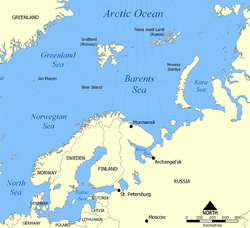Voyage
Convoy JW 51A departed Loch Ewe on 15 December 1942, accompanied by its local escort, of three destroyers, and its close escort. Three days later, on 18 December, it was joined by the ocean escort, while the local escort departed. At the same time the Cruiser Force and the Distant Cover Force from Scapa Flow also put to sea, taking station in the Norwegian Sea. The convoy was not seen by German reconnaissance aircraft, nor by any of the patrolling U-boats, and crossed the Norwegian and Barents Seas without incident. On 25 December Convoy JW 51A arrived safely at Kola Inlet but five ships were sunk in the inlet by mines and attacks by the Luftwaffe. Five ships sailed on to Molotovsk, near Archangelsk.
This page is based on this
Wikipedia article Text is available under the
CC BY-SA 4.0 license; additional terms may apply.
Images, videos and audio are available under their respective licenses.
